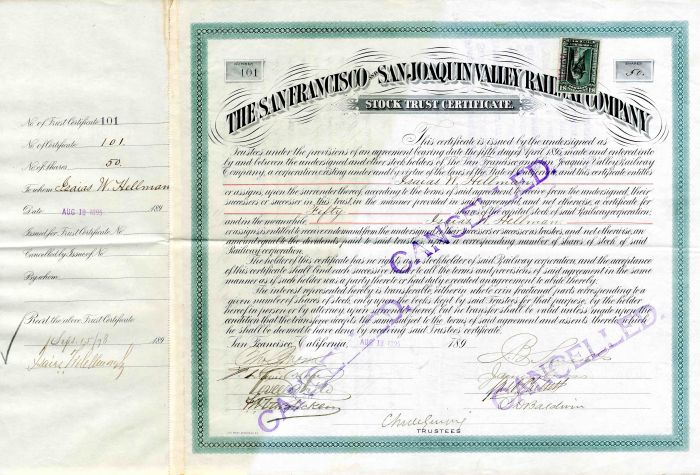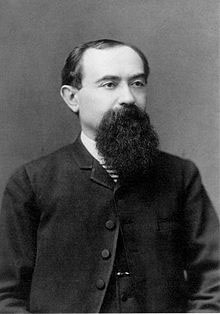San Francisco and San Joaquin Valley Railroad Co. Issued to and Signed by Isaias W. Hellman twice - Stock Certificate
Inv# AG2323 Stock
Stock issued to and signed by Isaias W. Hellman at back and stub. Rare!

Isaias Wolf Hellman (October 3, 1842 – April 9, 1920) was a German-born American banker and philanthropist, and a founding father of the University of Southern California. One of three sons and four daughters, Isaias was born in Reckendorf, Bavaria, to German Jewish parents Wolf Hellmann (1815–1884), a master weaver, and Sara Fleischmann (1823–1888). He was educated in German public schools and at the College of Marktbreit, Bavaria. This school was founded by Solomon Wohl in 1849. Isaias and his brother Herman W. Hellman left Hamburg on the steamer Hammonia, arriving in the Los Angeles, California on May 14, 1859 to join their cousins. A third brother James W. Hellman (1861-1940) also emigrated to Los Angeles.
Hellman went to work as a clerk in his cousins' stationery and cigar store, and learned to speak Spanish. The store operated as Hellman and Bro. and sold cigars and stationery, and was located at the corner of Main and Temple streets. Isaias joined the business in 1855, brother Sam in 1857,and the partnership was dissolved Jan. 26, 1862. In 1865, Hellman bought the dry goods store of Adolph Portugal at the corner of Main and Commercial that Portugal had opened in 1854. This is approximately the current location of the Triforium sculpture on the Los Angeles Mall. Some sources state that he opened a dry goods store in April 1865 “on the Baker Block”. The Baker Block did not open until 1875, however is one short city block north of Hellman's store at the southeast corner of Main and Commercial streets. In 1870 Hellman erected the Hellman Block at the northwest corner of Los Angeles Street and (a street that no longer exists) Commercial Street.
Hellman became Los Angeles' first banker almost by accident. As a courtesy, he stored his customers' gold and valuables in a safe. One day, Hellman got into an altercation with a drunk customer who had been coming in and out of the store, withdrawing gold each time from a pouch stored in the safe. When the man sobered up, he was angry to discover he had spent most of his funds, and lunged at Hellman. That interaction prompted Hellman to stop his informal banking operations. He obtained printed slips reading I.W. Hellman, Banker, and started buying people's funds and issuing deposit books.
On September 1, 1868, Hellman and Temple founded Hellman, Temple and Co., the fledgling city's second official bank. In 1871, Hellman and John G. Downey, a former governor of California, formed the Farmers and Merchants Bank of Los Angeles, which became Los Angeles' first successful bank. Hellman lent the money that allowed Harrison Gray Otis to buy the Los Angeles Times and Edward Doheny and Charles A. Canfield to drill for oil.
In 1881, Hellman was appointed a Regents of the University of California to fill the unexpired term of D.O. Mills. He was reappointed twice and served until 1918. In 1890, Hellman moved to San Francisco to take over the Nevada Bank, which had been formed in 1875 by four men known as the Silver Kings: John MacKay, James Flood, William O'Brien and James Fair. While the bank had once had $10 million in capitalization, it was nearly broke by the time Hellman took over. When word got out about Hellman's involvement, millionaires and capitalists from around the world applied to buy stock. Hellman had $15 million in applications but only $2.5 million in stock to sell. Two of the biggest shareholders included Mayer Lehman of Lehman Brothers ($150,000) and Levi Strauss ($120,000). Other shareholders included men Hellman had grown up with in Reckendorf who had become important businessmen, including Kalman, Abraham and William Haas, and David Walter. Hellman was president of the Nevada Bank of San Francisco from 1890 to 1898 and nationalized the bank under the title of The Nevada National Bank of San Francisco from 1898 to 1905. 1905 Hellman bought the banking division of Wells Fargo and merged it with The Nevada National Bank under the new title of Wells Fargo Nevada National Bank of San Francisco and was president of the bank until his death in 1920. In 1893, Hellman had incorporated the Union Trust Company. Union Trust Company was later merged into Wells Fargo Nevada National Bank in 1923 creating Wells Fargo Union Trust Company which became Wells Fargo Bank. At the height of his power, Hellman served as president or director of 17 banks along the Pacific Coast and controlled $100 million in capital.
Hellman was a major investor in trolley lines, contributing funds in 1874 to start the Main Street and Agricultural Park Railway, which traveled from the Plaza, the heart of Los Angeles's downtown, to Agricultural Park, a horse-racing track. Hellman eventually invested in many of the city's rail lines and with Henry Huntington formed the Los Angeles Railway in 1898 and the Pacific Electric Railway in 1901.
Hellman was a major investor in Los Angeles's water, gas and electricity companies, and helped bring Southern Pacific Railroad to Los Angeles in 1876, which ended the isolation of the region.
Hellman was president of B'nai B'rith in 1872 when the congregation built the city's first temple on Fort Street. In 1870, his cousin Isaiah M. Hellman was elected City Treasurer.
Hellman was a major landowner in Southern California. His holdings included numerous city lots and vast swaths of former rancho land. In 1871, he and a syndicate bought the 13,000-acre (53 km2) Rancho Cucamonga. In 1881, Hellman and members of the Bixby family purchased the 26,000-acre (110 km2) Rancho Los Alamitos (now home to Long Beach and Seal Beach). The Hellman neighborhood of Long Beach bears his name. He also purchased the Repetto Ranch (now Montebello) with Harris Newmark and Kaspare Cohn. Hellman and Downey also purchased swaths of Rancho San Pedro from the Dominguez family. Hellman owned much of Boyle Heights with William H. Workman.
In 1897, Hellman bought a large parcel of land next to Lake Tahoe where he built a mansion in 1903. He named it Pine Lodge after the sugar pines on the property. His family later sold this land to the state of California, which made the property into Sugar Pine Point State Park.
He purchased the 35,000-acre (140 km2) Nacimiento Ranch near Paso Robles and stocked it with cattle and horses. In 1905, Hellman merged the Nevada National Bank with Wells Fargo Bank to form the Wells Fargo Nevada National Bank. After the 1906 San Francisco earthquake, the bank was operated in the residence of Hellman's son-in-law at 2020 Jackson Street while the headquarters was rebuilt. In 1879, Judge Robert Maclay Widney established a board of trustees to create a new university. Hellman joined the businessman Ozro W. Childs and the former Governor of California John G. Downey in donating valuable land and an endowment to found the University of Southern California.
A stock certificate is issued by businesses, usually companies. A stock is part of the permanent finance of a business. Normally, they are never repaid, and the investor can recover his/her money only by selling to another investor. Most stocks, or also called shares, earn dividends, at the business's discretion, depending on how well it has traded. A stockholder or shareholder is a part-owner of the business that issued the stock certificates.









Ebay ID: labarre_galleries